Supplemental Digital Content is available in the text
Keywords: auricular acupressure, meta-analysis, obesity, overweight
Abstract
Background:
Auricular acupressure has been used for treating obesity, but inconsistent outcomes have been reported. Moreover, systematic reviews and meta-analyses have seldom addressed the effects of auricular acupressure and duration of treatment in overweight/obese individuals. This study reviewed research articles on auricular acupressure for weight reduction, analyzed the related effects on obesity, and explored the relationships between weight reduction and treatment duration, as well as outcome variables.
Methods:
We searched PubMed, Cochrane Library, CINAHL, MEDLINE with Full Text, National Digital Library of Theses and Dissertation in Taiwan, and Airiti Library for articles up to July 4, 2018. Eight eligible trials were identified for qualitative synthesis, and one of them was excluded from quantitative synthesis. Inclusion criteria were as follows: intervention contained auricular acupressure, study subjects were overweight and/or obese, as defined by published authors, and the study design had 2 or more arms for comparison.
Results:
Pooled analysis of the 7 remaining studies revealed that auricular acupressure alone, or with diet and/or exercise, was effective for weight reduction, particularly for decreasing body weight (BW), body mass index (BMI), waist circumference (WC), waist-to-hip ratio (WHR), body fat mass (BFM), and body fat percentage (BFP), compared with no treatment, sham treatment, or use of surgical tape with diet and/or exercise. However, there was no effect on hip circumference. A 12-week acupressure intervention was associated with a larger effect on lowering BW and BMI compared with 4-, 6-, and 8-week interventions. The methodologic quality of trials included in the quantitative synthesis ranged from scores 2 to 6 based on the modified Jadad scale. Additionally, this meta-analysis combined studies that used different acupoints and outcomes evaluated at different timepoints, which may have been potential sources of bias.
Conclusion:
The study results indicate that auricular acupressure is effective for weight reduction. However, further vigorous studies that use double-blind randomized controlled design are needed to verify these findings. WC, WHR, BFP, or BFM should be used as obesity-related parameters in weight reduction studies to detect changes in fat, muscle, and skeletal weight.
1. Introduction
Overweight and obese individuals are at an increased risk of ischemic/hypertensive heart disease, ischemic/hemorrhagic stroke, diabetes mellitus, and breast cancer.[1] Research[1] has indicated that a body mass index (BMI) equal to or >30 was responsible for 61% of worldwide deaths and 60.6% of disabilities in patients with cardiovascular diseases, cancers, chronic kidney disease, and diabetes mellitus in 2015. Further, a BMI between 25 to 29 contributed to 32.4% of deaths and 30.8% of disabilities among these patients.[1] In Taiwan, the rate of overweight and obese adults was 32.7% in 1993 to 1996, 43.4% in 2005 to 2008, and 44.8% in 2013 to 2015.[2] Approximately 10% of health care expenditures were used to treat hypertensive disease, heart disease, and diabetes mellitus.[3–6] Therefore, weight reduction is an important public health issue that needs to be addressed to improve the overall health of individuals and health care expenditures.
Acupuncture, including auricular acupressure, has been commonly used to reduce body weight (BW) and treat obesity and various health problems.[7–10] Auricular acupressure involves taping organic seeds, such as green beans, rice, and Vaccaria, or magnetic pellets on acupoints located on the external ears, and then pressing down on the acupoints with a gentle force until the sensation of burning, soreness, numbness, distension, or heat is felt. This kind of sensation is called “de qi.”[11] Stimuli, such as a needle, pressure (e.g., seed or magnetic pellet), electricity, laser, and temperature, can activate acupoints and further restore dynamic harmonious status of qi.[12] According to its definition, all of these diverse stimulating techniques are included in “acupuncture.”[13] Compared to body acupoints, the utilization of auricular acupoints does not require clients to remove clothes or expose their body; therefore, the procedure is more convenient than the use of body acupoints.[14] Additionally, the application of pressure for stimulation of acupoints reduces the risk of adverse events, such as bleeding, hematoma, or infection, that are associated with the use of thin stainless steel needles.[15–17]
The effects of acupuncture on BW have been reported to be inconsistent.[18–20] Cho et al[18] evaluated all types of acupuncture, including body and auricular acupuncture by needle, electricity, catgut implantation, and pressure, for the treatment of obesity. They reported that acupuncture was effective for weight reduction compared with no treatment, placebo, sham acupuncture, and pharmacologic or nonpharmacologic treatments. Yeh et al[19] and Ruan et al[20] reviewed randomized controlled trials (RCTs) with 2 to 3 modes of acupuncture interventions: needle, pressure, and electricity. Yeh et al[19] reported that auricular acupuncture was effective for weight loss compared with no treatment, sham acupuncture, and (surgical) tapes. However, Ruan et al[20] reported that auricular acupuncture alone was less effective compared with auricular acupuncture combined with diet control and/or exercise.
In addition to inconsistent reports regarding the effect of acupuncture on weight reduction, previous reviews and meta-analyses have seldom addressed the effects of auricular acupressure, treatment duration, and numbers and locations of the stimulated acupoints as well as the outcomes variables. Therefore, this study aimed to review research articles on the effects of auricular acupressure on weight reduction, analyze these effects on weight reduction, and explore the relationships between weight reduction and treatment duration as well as the outcome variables.
2. Method
2.1. Search strategy
This study adheres to the Preferred Reporting Items for Systematic Reviews and Meta-Analyses (PRISMA) guideline.[21] Our study focuses on qualitative and quantitative syntheses of previous studies, in which subjects’ informed consents have already been obtained. Therefore, ethical approval was not necessary. We evaluated trials that included overweight and obese subjects, aged 18 to 60 years, who were treated using auricular acupressure by seeds or magnetic pellets alone, or in combination with exercise and/or diet, in comparison with exercise and/or diet, for weight reduction. We did not use “age,” “human,” and “RCTs” as limits because the database of Airiti Library has its limitations in advanced search and the quality of research methodology may be poor.[18] Studies were included if they met the following criteria: intervention included auricular acupressure, study subjects were overweight and/or obese, as defined by published authors, and the study design had 2 or more arms for performing comparison: acupressure and control groups (i.e., no treatment, sham treatment, or use of surgical tape). The exclusion criteria were as follows: language of publication other than English or (Mandarin and Simplified) Chinese; animal trials; age of study subjects <18 years; study focus not on weight reduction (e.g., changes in leptin level or appetite); study subjects having other health conditions (i.e., major depressive disorder, diabetes mellitus, schizophrenia, metabolic syndrome, or polycystic ovary syndrome); study design involving 1-group pre- and post-test or cross-over; and interventions involving stimulation of acupoints other than auricular acupressure (e.g., needles, laser, electricity, catgut, and needle embedding); or studies that involved a combination of auricular acupressure with other treatments, such as cupping, moxibustion, Tui Na (massage), and Western or Chinese medicine.
We searched electronic databases, including PubMed, Cochrane Library, CINAHL, MEDLINE with Full Text, National Digital Library of Theses and Dissertation in Taiwan (NDLTD), and Airiti Library, for articles up to July 4, 2018. Considering that acupuncture includes “a variety of procedures” based on its definition,[13] we used key words in both English and Chinese, including “auricular acupressure,” “auricular point tapping,” “auricular point acupressure,” “auricular acupuncture,” “ear acupuncture,” “ear pressing,” “obesity,” “overweight,” “weight reduction,” and “weight loss” by Boolean search.
2.2. Selection of studies and data extraction
Two investigators (C-F Huang and S-E Guo) independently searched and screened databases for eligibility by a series of steps: (1) title reading, (2) abstract reading, (3) research method reading, and (4) discussion between investigators. When a consensus regarding eligibility was reached, we critically read and extracted data, including study information (authors, publication years, and location), sample size and characteristics (age and gender), intervention and control descriptions (frequency, duration, chosen acupoints, and monitoring methods), and mean and standard deviation of outcome measurements (such as BW, BMI, waist circumference [WC], hip circumference [HC], waist-to-hip ratio [WHR], body fat percentage [BFP], and body fat mass [BFM]) from the pre- and post-test. The primary outcomes were BW and BMI and the secondary outcomes were WC, HC, WHR, BFP, and BFM in the acupressure and control groups. BFM was calculated by multiplying BW and BFP.
2.3. Risk of bias assessment
Methodologic quality was assessed by the modified Jadad scale.[22] It scores 8 items as follows: state the study as randomized, report randomization procedure appropriately, describe the study as double blind, report double blinding procedure appropriately, reveal withdraws and dropouts, list inclusive and exclusive criteria, report monitoring methods on adverse effects, and describe statistical method. The scores range from 0 to 8; a higher score indicates higher quality of study methodology. We scored the chosen articles while extracting data. Any incongruence between 2 investigators (CFH and SEG) was reassessed and discussed until a consensus was reached.
2.4. Statistical methods
Random effects models were used to pool the estimates of the primary and secondary outcomes from individual studies for each arm (acupressure and control). In contrast to a fixed effects model, a random effects model allows for the true underlying effect to vary among individual studies. Heterogeneity across the studies was assessed using I2, with a value higher than 25%, 50%, and 75% indicating low, moderate, and high heterogeneity, respectively.[23] The pooled estimates among subgroups (different types of controls used) were compared using mixed effects models. The correlation between the duration of intervention and strength of the pooled estimates was tested using random effect meta-regression. Publication bias was assessed by a funnel plot and Egger test. Statistical significance was set at P < .05 with a 2-tailed test. Data analyses were performed using Comprehensive Meta-Analysis 2.2 (CMA 2.2; Biostat, Inc, Englewood, NJ).
3. Results
3.1. Study selection
The flowchart of study selection for the systematic review and meta-analysis is shown in Figure 1. A total of 354 records were identified from the initial search (197 studies from Airiti Library, 17 from CINAHL, 48 from Cochrane, 46 from MEDLINE, 38 from PubMed, and 8 from NDLTD). Among these, 77 records were excluded because of duplication; in addition, 264 records were excluded by reading titles and abstracts (articles written in non-English or non-Chinese [n = 3], studies conducted on animals [n = 2], patients aged <18 yeas [n = 14], studies focused on other issues [n = 13], patients having other disease conditions [n = 14], 1-group pre- and post-test studies [n = 17], use of intervention other than auricular acupressure or in combination with other methods [n = 185], review articles [n = 9], articles published in another language or journal [n = 2], published master theses [n = 2], conference abstract [n = 1], and use of acupressure devices [n = 2]).
Figure 1.
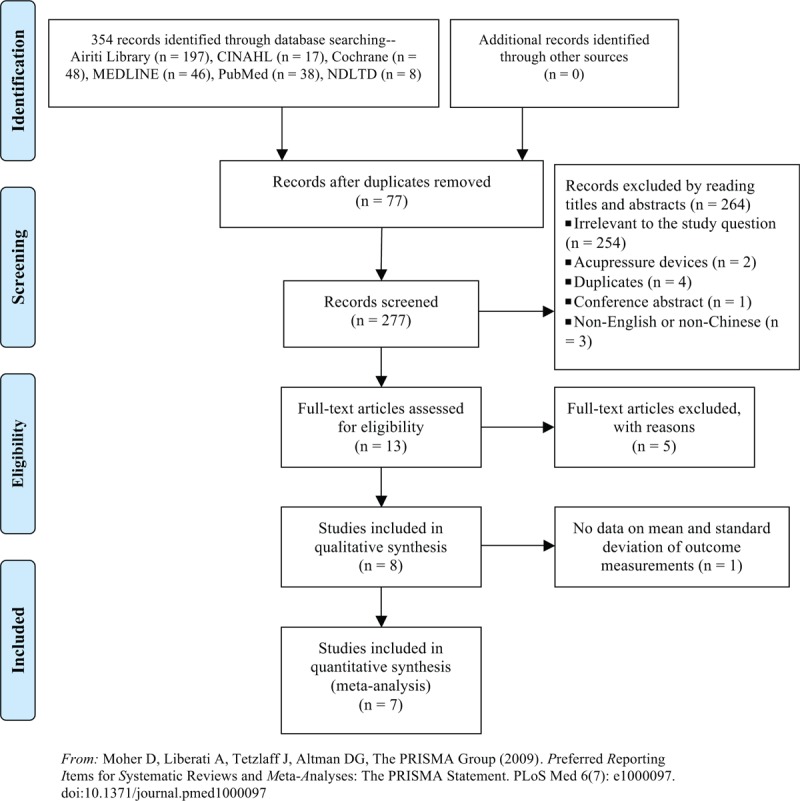
The flowchart of study selection for the systemic review and meta-analysis based on the Preferred Reporting Items for Systematic Reviews and Meta-Analyses (PRISMA) guideline. A total of 354 records were identified from the initial search. Overall, 8 studies were eligible for the systematic review; seven studies were eligible for the quantitative analysis.
The remaining 13 full-text articles were evaluated for eligibility. Five articles were excluded from qualitative synthesis because they were duplicates from another included study (n = 3), allocated by combining obese and nonobese subjects (n = 1),[24] and used a cross-over design (n = 1). Two master theses (Hsieh, MS, unpublished data, February 2012; Tseng, MS, unpublished data, June 2006) were further discussed for inclusion. Although these were unpublished studies, their titles, abstracts, and research methods were consistent with our inclusion criteria. The consensus for eligibility was reached because their scores on the modified Jadad scale[22] were 3 (Hsieh, MS, unpublished data, February 2012) and 5 (Tseng, MS, unpublished data, June 2006). Overall, a total of 8 studies were eligible for the systematic review. One study[25] that only reported the amount of changes for outcome variables was excluded from the meta-analysis. Therefore, a total of 7 studies were eligible for the quantitative analysis. The studies conducted by Hsieh (MS, unpublished data, February 2012) and Lee[26] contained 2 control groups (no treatment and surgical tapes), resulting in a total of nine comparisons in the meta-analysis.
3.2. Study characteristics
Table 1 presents the characteristics of the 8 included studies,[7,25–29] which were published between 2006 and 2014. The studies were conducted in Iran,[27,28] China,[26,29] Taiwan[25] (Hsieh, MS, unpublished data, February 2012, Tseng, MS, unpublished data, June 2006), and South Korea.[7] Sample sizes ranged from 40 to 204 and mainly comprised female subjects. The duration of interventions was 4,[7,29] 6,[27,28] 8[25] (Hsieh, MS, unpublished data, February 2012, Tseng, MS, unpublished data, June 2006), or 12 weeks.[26] (Tseng, MS, unpublished data, June 2006). None of these trials followed up after interventions or reported significant differences in the baseline characteristics between the experimental and control groups.
Table 1.
Characteristics of the included studies.
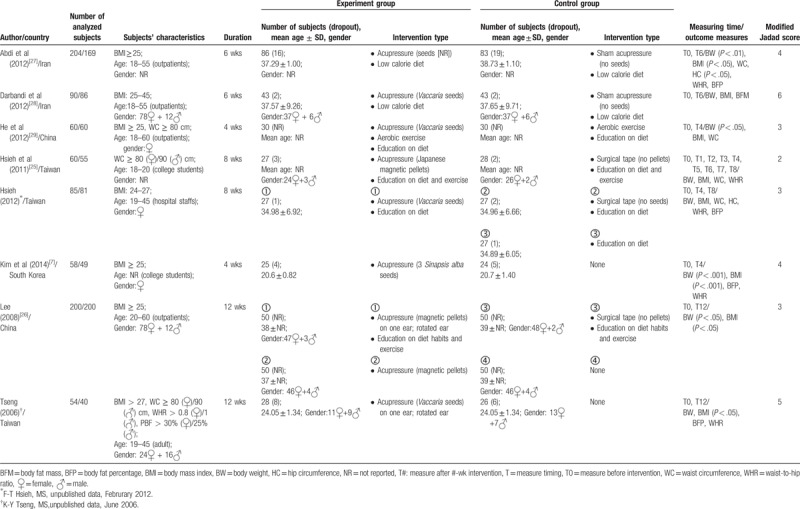
The interventions utilized in the studies were categorized as follows (Table 2 ). Interventions in the experimental groups comprised auricular acupressure by organic seeds or magnetic pellets alone[7,26] (Tseng, MS, unpublished data, June 2006), or in combination with a decreased calorie diet,[27,28] diet education (Hsieh, RN, unpublished data, February 2012), education on diet and exercise,[25,26] or diet education and exercise.[29] Interventions in the control groups comprised no treatment[7,26] (Tseng, MS, unpublished data, June 2006), diet education (Hsieh, MS, unpublished data, February 2012), diet education and exercise,[29] surgical tapes (no seeds, same acupoints) plus diet education (Hsieh, MS, unpublished data, February 2012) or education on diet and exercise,[25,26] or sham acupressure (no seeds, different acupoints) plus a decreased calorie diet.[27,28] Apart from cases in which a low-calorie diet plan was formulated by a nutritionist, it was difficult to determine the subjects’ compliance with regard to exercise and diet control, although various methods, such as written logs[7,26,29] (Hsieh, MS, unpublished data, February 2012, Tseng, MS, unpublished data, June 2006), phone,[7] and text messages,[7] were utilized to evaluate the quality of compliance with activities, diet control, or stimulation of acupoints upon which seeds or pellets were adhered by (surgical) tapes.
Table 2.
Descriptions of interventions of the included studies.
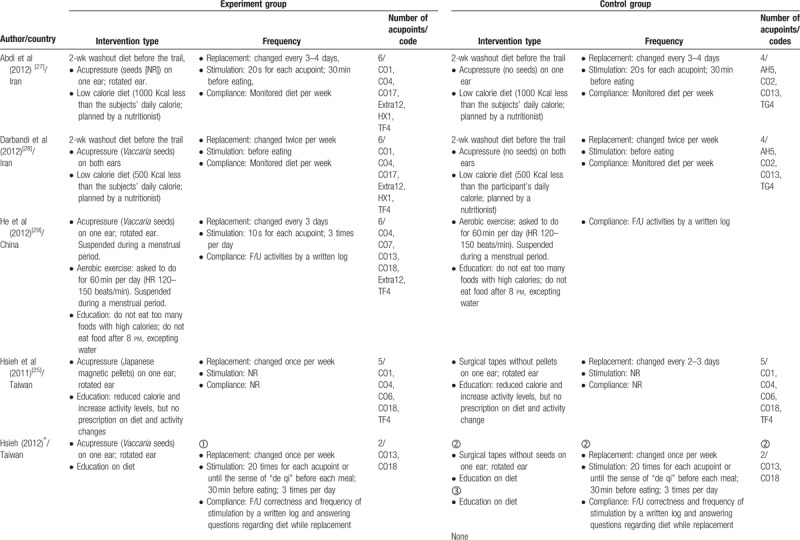
Table 2 (Continued).
Descriptions of interventions of the included studies.
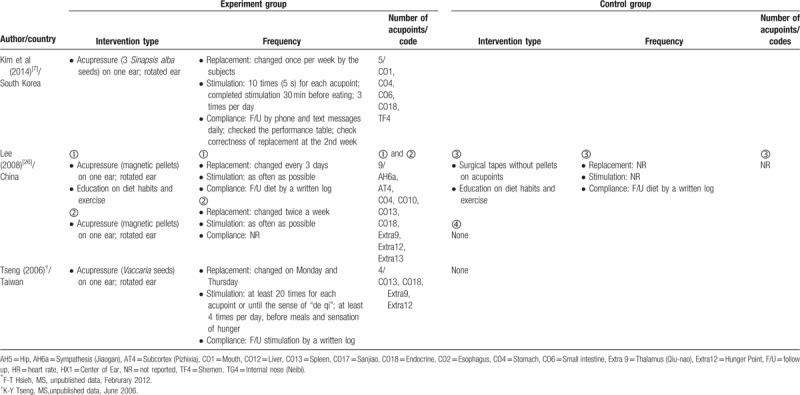
The descriptions of acupressure techniques varied in terms of whether one/both ears were involved, the frequency of replacing seeds/pellets and tapes, and the pressing duration and frequency. Only Darbandi et al[28] utilized acupressure on both auricles simultaneously; others used the intervention alternately for both ears. In only 3 studies[7,25] (Hsieh, MS, unpublished data, February 2012), seeds/pellets and tapes were changed once a week; in others, they were changed twice per week. The replacements were administered by the acupuncturist,[27,28] Chinese medical doctor,[26,29] trained health professional[25] (Hsieh, MS, unpublished data, February 2012, Tseng, MS, unpublished data, June 2006), or the subjects themselves.[7] In all studies, except for the study by Hsieh et al,[25] subjects were asked to stimulate each acupoint along with seeds/pellets in various manners: 20 seconds for each acupoint and 30 minutes before eating,[27] before eating,[28] 10 seconds for each acupoint 3 times per day,[29] 10 times (5 seconds) for each acupoint and completing pressing 30 minutes before eating, 3 times per day,[7] as often as possible,[26] 20 times for each acupoint or until the sense of “de qi” before each meal (Hsieh, MS, unpublished data, February 2012), and at least 20 times for each acupoint or until the sense of “de qi,” and at least 4 times per day, before meals and feelings of hunger (Tseng, RN, unpublished data, June 2006).
The numbers and location of chosen acupoints varied according to the diverse Chinese traditional medicine (CTM) theories, individual clinical experiences, and subjects’ conditions, except for the studies by Kim et al[7] and Hsieh et al[25] as well as Abdi et al[27] and Darbandi et al[28] which used the same acupoints. The numbers of chosen acupoints were 2 (Hsieh, RN, unpublished data, February 2012), 4 (Tseng, RN, unpublished data, June 2006), 5,[7,25] 6,[27–29] and 9.[26] CO4[7,25–29] and CO18[7,25,26,29] (Hsieh, MS, unpublished data, February 2012, Tseng, MS, unpublished data, June 2006) were the most frequently chosen acupoints. Extra12[26–29] (Tseng, MS, unpublished data, June 2006) and TF4[7,25,27–29] were the 2nd most commonly chosen acupoints. CO1[7,25,27,28] and CO13[26,29] (Hsieh, MS, unpublished data, February 2012, Tseng, MS, unpublished data, June 2006) were the 3rd most commonly chosen acupoints; however, 2 studies[27,28] used CO13 for sham treatment in the control group.
3.3. Risk of bias
The modified Jadad scale was utilized to evaluate the methodologic quality of the 8 included studies (see Table, Supplemental Content 1, which illustrates the score on each item based on the modified Jadad scale). The scores ranged from 2 to 6. None of the studies were described as double blinded. Only 1 study[28] reported no adverse effects.
3.4. Primary and secondary outcomes
Figure 2 presents the pooled analysis of the 2 primary outcomes. The mean differences between the experimental and control groups for BW was −2.01 kg (95% confidence interval [CI] = −3.78 to −0.25, I2 = 80.1%, P = .03) and BMI was −0.95 kg/m2 (95% CI = −1.50 to −0.40, I2 = 85.8%, P = .001). Figure 3 presents the pooled analysis of the 4 secondary outcomes. The mean differences between the experimental and control groups for WC, WHR, BFP, and BFM were −1.54 cm (95% CI = −1.93 to −1.15, I2 = 0%, P < .001), −0.011 (95% CI = −0.016 to −0.005, I2 = 36.7%, P < .001), −1.20% (95% CI = −1.74 to −0.67, I2 = 36.5%, P < .001), and −0.89 kg (95% CI = −1.61 to −0.16, I2 = 3.9%, P = .02), respectively. The mean difference of HC between the experimental and the control groups was −1.70 cm (95% CI = −4.50 to −1.11, I2 = 84.1%, P = .24).
Figure 2.
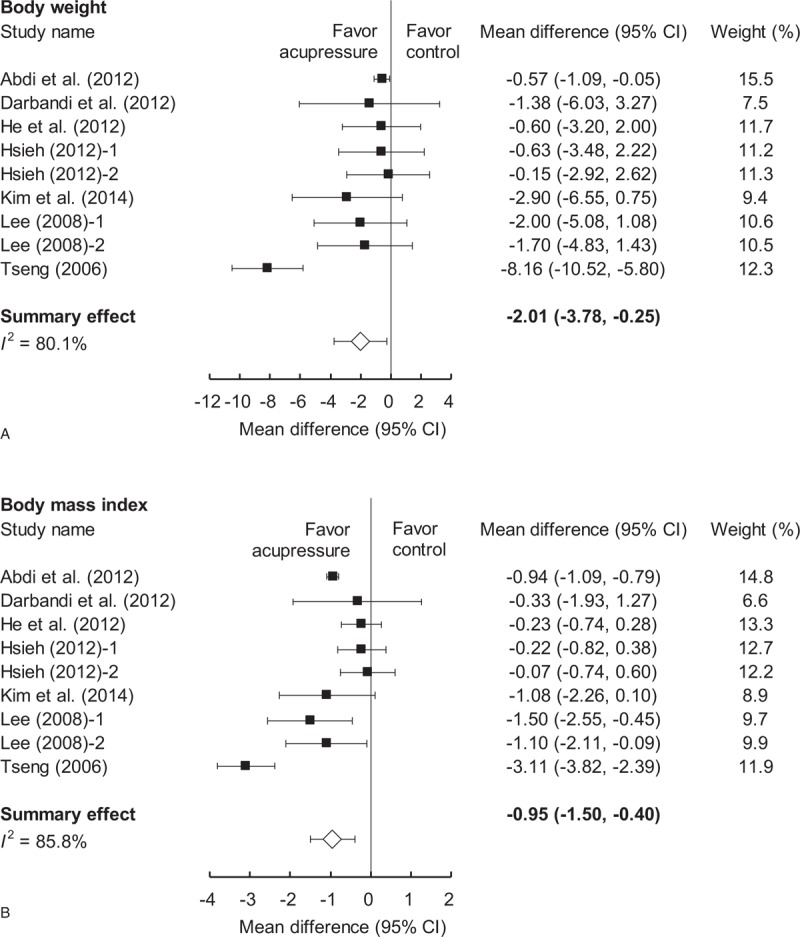
The effect of acupressure on body weight (BW) and body mass index (BMI) comparing with control groups. The mean differences between the experimental and control groups for (A) BW was −2.01 kg (P = .03) and (B) BMI was −0.95 kg/m2 (P = .001).
Figure 3.
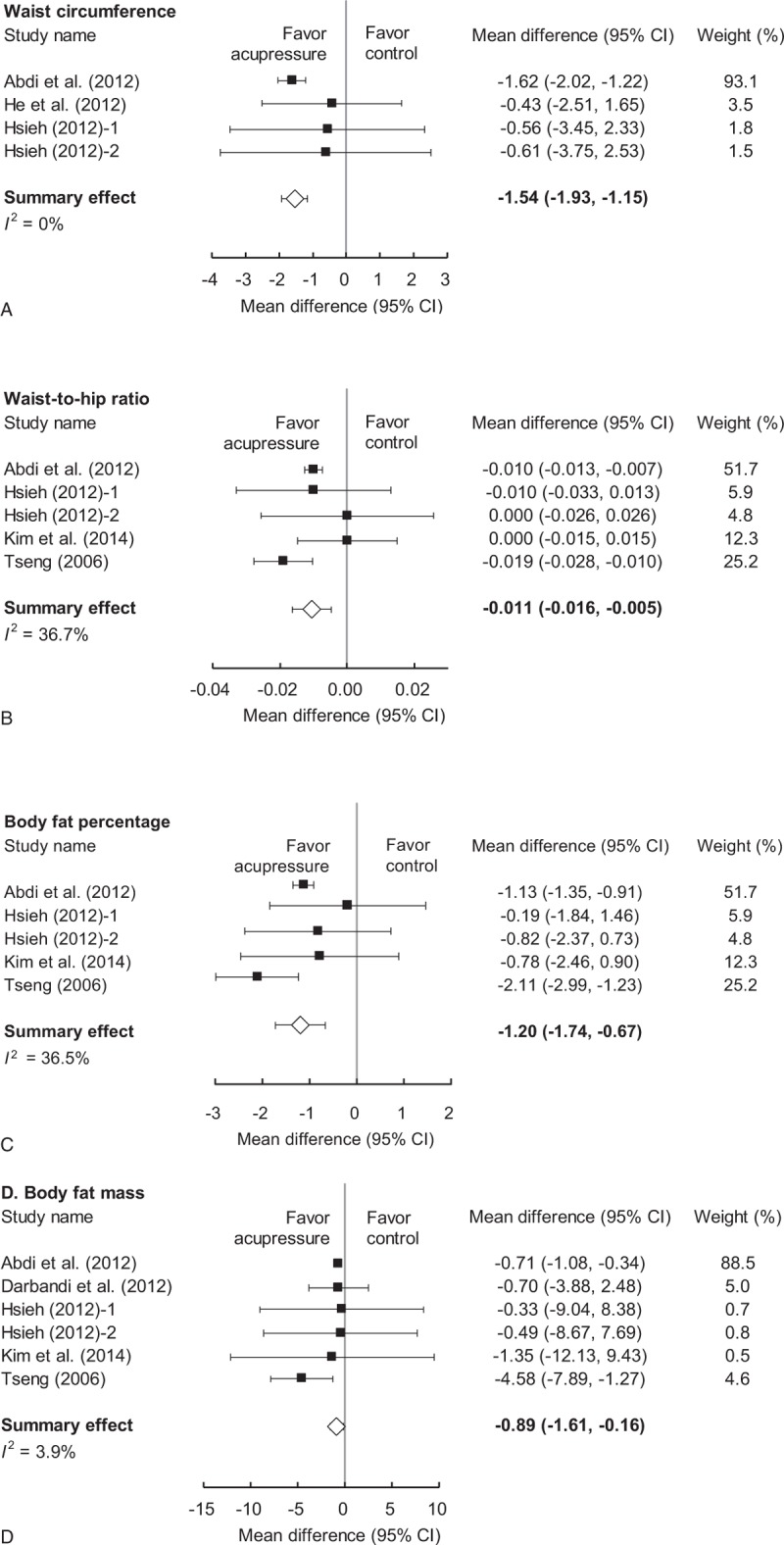
The effect of acupressure on waist circumference (WC), waist-to-hip ratio (WHR), body fat percentage (BFP), and body fat mass (BFM), comparing with control groups. The mean differences between the experimental and control groups for WC (A), WHR (B), BFP (C), and BFM (D) were −1.54 cm (P < .001), −0.011 (P < .001), −1.20% (P < .001), and −0.89 kg (P = .02), respectively.
3.5. Subgroup analyses
We categorized the interventions used in the control subjects as “none” or “same” (i.e., no intervention or the same intervention except auricular acupressure)[7,26,29] ( Hsieh, MS, unpublished data, February 2012, Tseng, MS, unpublished data, June 2006), sham treatment,[27,28] and surgical tape[26] (Hsieh, MS, unpublished data, February 2012). Subgroup analyses were performed to examine whether the type of intervention in the control group moderated the intervention effect. The effect of acupressure in terms of reduction in BW, BMI, WC, BFP, and BFM did not differ significantly among interventions (none or same, sham treatment, and surgical tape) in the control groups (Fig. 4).
Figure 4.
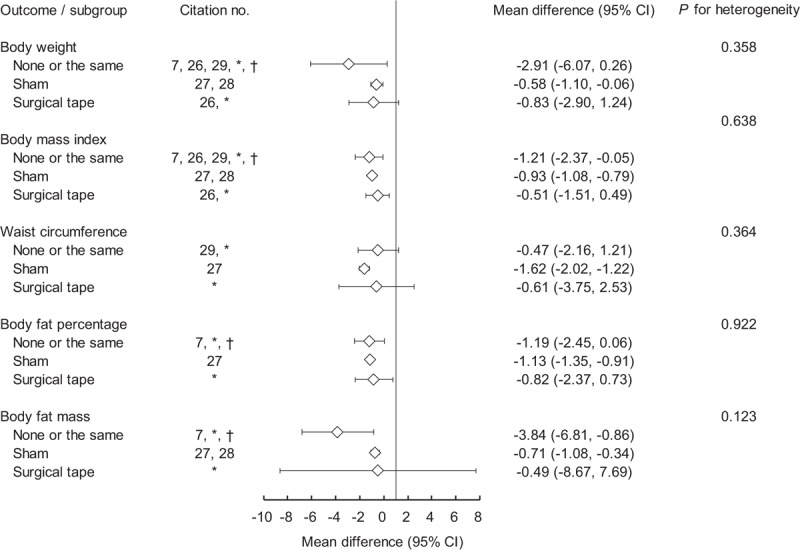
The effect of acupressure in terms of reduction in body weight (BW), body mass index (BMI), waist circumference (WC), body fat percentage (BFP), and body fat mass (BFM) among interventions used in the control groups. The types of interventions in the control groups did not significantly moderate the intervention effect. ∗F-T Hsieh, MS, unpublished data, February 2012. †K-Y Tseng, MS, unpublished data, June 2006.
The effect of treatment duration on primary outcomes (BW and BMI) was analyzed by meta-regression. Figure 5 shows that longer treatment duration was associated with a larger effect of acupressure in terms of reduction in BW (B = −0.58, P < .001) and BMI (B = −0.17, P < .001), respectively. The effect of a 12-week intervention on BW and BMI was greater than those of 4-, 6-, and 8-week interventions.
Figure 5.
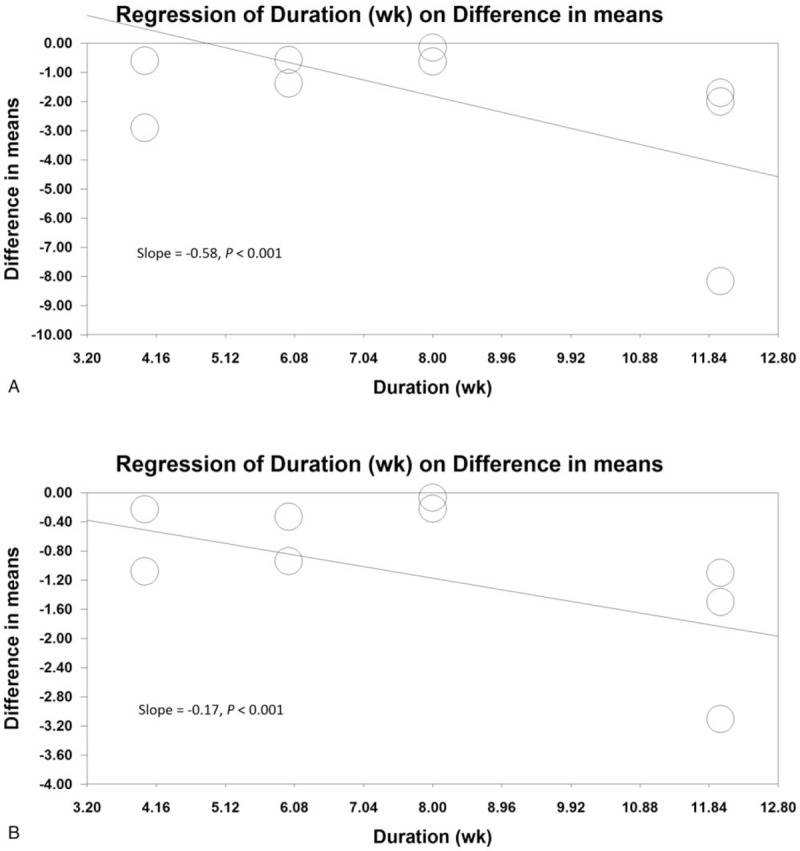
The effect of treatment duration on body weight (BW) and body mass index (BMI). Longer treatment duration was associated with a larger effect of acupressure in terms of reduction in (A) BW (P < .001) and (B) BMI (P < .001), respectively. The effect of a 12-week intervention on BW and BMI was greater than those of 4-, 6-, and 8-week interventions.
3.6. Publication bias
Publication bias was examined only for primary outcomes. The distribution of dots on the funnel plot was not significantly asymmetric and the results of Egger test were not significant (P = .25 and P = .97 in BW and BMI, respectively), indicating the absence of publication bias in this meta-analysis (see Figure, Supplemental Content 2, which illustrates the funnel plot for publication bias on BW and BMI).
3.7. Sensitivity analysis
Sensitivity analysis was performed on primary outcomes (BW and BMI). First, we examined whether removing any single study altered the conclusion. Second, we combined the results of 2 different control groups (none and surgical tape) from the studies of Lee[26] and Hsieh (MS, unpublished data, February 2012) and then performed the meta-analysis again. The results showed that the pooled estimates were statistically significant in the sensitivity analyses.
4. Discussion
To the best of our knowledge, this was the 1st study to perform a meta-analysis that focused on the effects of auricular acupressure on BW, BMI, WC, WHR, BFP, and BFM among adults. Information on the effects of auricular acupressure is crucial for developing appropriate and effective interventions and procedures to improve adults’ BW and overall health. This study addressed a gap in the existing literature by providing evidence on the effects of auricular acupressure on overweight and obese adults. We also examined the effects of treatment duration and outcome variables of auricular acupressure in the study population.
This study identified 8 studies in the systematic review and selected 7 studies for the meta-analysis on weight reduction. Pooled analyses of the 7 studies revealed that auricular acupressure alone, or with diet and/or exercise, was effective for weight reduction, particularly for decreasing BW, BMI, WC, WHR, BFP, and BFM, compared with no treatment, sham treatment, or use of surgical tape with diet and/or exercise. However, there was no difference in HC between the experimental and control groups. We also found that a longer intervention duration was associated with a larger effect of acupressure on lowering BW and BMI.
Among the outcome variables in this study, BW was the most commonly analyzed in meta-analyses regarding weight reduction. Similar to the findings of Cho et al[18] and Yeh et al,[19] our findings indicated that acupuncture was effective in reducing BW. Cho et al[18] included 29 trials in their meta-analysis; however, they only categorized and analyzed 1 trial[30] that utilized the Tapas Acupressure Technique as the treatment intervention. Yeh et al[19] included 12 trials in their quantitative synthesis; however, 1 study[31] targeted individuals who were suffering from schizophrenia. Schizophrenia is a chronic disorder that may cause anhedonia, avolition, inactivity, and social withdrawal. Individuals with schizophrenia may be prone to adopt a sedentary lifestyle, which increases the risk of weight gain. Additionally, the use of antipsychotics is associated with weight gain.[32,33] The population of subjects with schizophrenia was too specific to be included in the present study.
Nevertheless, our findings were not consistent with those of a meta-analysis conducted by Ruan et al.[20] Their analysis included results from 9 trials and indicated that auricular acupuncture was not significantly effective for improving obesity unless it was combined with diet or diet and exercise. This discrepancy between our findings and those of Ruan et al[20] may be attributed to the fact that the studies included in the 2 analyses used different acupressure techniques, study populations, and treatment interventions. In the study by Ruan et al,[20] 4 RCTs were included to examine the effects of auricular acupuncture (by needle or pressure) alone on weight control, and one[34] of the 4 trials used an acupressure device. Although this device offers convenience, its generalized use may be limited by the fact that it does not perfectly fit into the ears of all individuals. Further, Ruan et al[20] included 3 studies[34–36] that recruited obese individuals in the treatment and control groups; our study included overweight individuals. Therefore, it is possible that auricular acupuncture alone may be effective for overweight individuals but may need to be combined with other interventions to increase its effectiveness in obese individuals.
The BW and BMI are the most conveniently measured parameters and were used by all reviewed trials in the present study. Although our findings indicated that measurement of BW, BMI, WC, WHR, BFP, and BFM may be effective for the evaluation of weight reduction, many different outcome variables have been analyzed in previous studies on this topic. For example, Yeh et al[19] reported that auricular acupuncture (by needle and pressure with or without electricity) was effective for decreasing BMI, WC, and BFP, but ineffective in improving WHR. This inconsistency may be attributed to the duration of treatments that were included in our analyses and those of Yeh et al.[19] Yeh et al[19] analyzed 4 trials[7,25,27,36] for changes in the WHR, and the duration of these trials was 4,[7,36] 6,[27] and 8 weeks.[25] The duration of interventions in our analysis was 4,[7] 6,[27] 8 (Hsieh, MS, unpublished data, February 2012), and 12 weeks (Tseng, MS, unpublished data, June 2006). Therefore, it is possible that changes in the WHR take a longer time than changes in BMI, WC, and BFP.
The BW and BMI do not provide specific data on fat mass and skeletal and muscle weight or percentage. Additionally, sex and age should also be considered when evaluating these parameters.[37] WC, WHR, BFP, and BFM are important indicators of obesity-related diseases.[37–39] Therefore, it is recommended to utilize WC, WHR, BFP, or BFM as obesity-related parameters in weight reduction studies to detect changes in fat, muscle, and skeletal weight.
The results of our pooled analysis also revealed that 12 weeks of auricular acupressure had a greater effect on decreasing BW and BMI than the 4-, 6-, and 8-week interventions. Therefore, a 12-week treatment duration is recommended for achieving greater weight reduction.
Verification of the effectiveness of the numbers and locations of the chosen acupoints might be helpful in achieving better therapeutic effect in weight reduction, although CTM is considered to involve individualized medicine. In our meta-analysis, the numbers and locations of the chosen acupoints differed according to CTM theories, clinical experiences, and study designs, except in 2 studies.[27,28] It is difficult to determine which auricular acupoints are the best for decreasing BW and BMI. However, CO4, CO18, Extra12, TF4, CO1, and CO13 were the most commonly selected acupoints in most studies that examined auricular acupressure as an intervention for weight control.
Although overweight and obese individuals were instructed to exercise regularly and/or control diet, their compliance was not addressed or described in these studies. Except for cases where a low-calorie diet plan was formulated by a nutritionist, it was difficult to verify the subjects’ performance in exercise and diet control, although written logs, phone and/or text messages were utilized. Subjects’ compliance with regard to diet control and exercise is an important and complicated issue. Future studies that evaluate the effect of auricular acupressure on overweight and obese individuals should describe the characteristics of exercise, including, mode, duration, intensity, and frequency, and diet (calories or proportion of carbohydrates, protein, fat, vegetables, and fruits, and [midnight] snacks).
Auricular acupressure may be an alternative approach to assist individuals with weight control issues, particularly at the primary prevention level. Due to the noninvasive nature of auricular acupressure, this treatment can be administered by trained individuals without a background in the health professions. In a study conducted by Kim et al,[7] subjects were taught to adhere seeds on acupoints based on ballpoint pen markings and photos of acupoints on their auricles. However, the procedure of stimulating acupoints by needle with or without electricity may cause adverse events[16,17] and should be done by Chinese medical doctors or acupuncturists.
4.1. Limitations
Due to several limitations of the present study, our results should be interpreted with caution. First, the methodologic quality of the trials that were included in the quantitative synthesis ranged from 2 to 6 scores based on the modified Jadad scale; future studies should adopt a double-blind randomized controlled design to decrease bias. However, there is no evidence of any publication bias that may have affected our conclusion. Additionally, the meta-analysis combined studies involving stimulation of different acupoints, such as CO7, AT4, and CO10, and evaluation of outcomes at different timepoints, which could have introduced other sources of bias. Finally, future studies should not only investigate the effects of auricular acupressure, but also the safety issues associated with different types of auricular acupressure for weight control at different stages or for different types of chronic diseases.
Author contributions
Ching-Feng Huang, Su-Er Guo, and Fan-Hao Chou contributed to the conceptualization, data curation, formal analysis, investigation, resources, validation, writing, and editing of the study.
Supplementary Material
Footnotes
Abbreviations: BFM = body fat mass, BFP = body fat percentage, BMI = body mass index, BW = body weight, CTM = Chinese traditional medicine, HC = hip circumference, NDLTD = National Digital Library of Theses and Dissertation in Taiwan, PRISMA = Preferred Reporting Items for Systematic Reviews and Meta-Analyses, RCTs = randomized controlled trials, WC = waist circumference, WHO = World Health Organization, WHR = waist-to-hip ratio.
SEG and FHC contributed equally to this work.
The authors have no funding and conflicts of interest to disclose.
Supplemental Digital Content is available for this article.
References
- [1].GBD Obesity Collaborators. Health effects of overweight and obesity in 195 countries over 25 years. N Engl J Med 2017;377:13–27. [DOI] [PMC free article] [PubMed] [Google Scholar]
- [2].Ministry of Health and Welfare. 2016 annual report [in Chinese]. Available at: https://www.hpa.gov.tw/Pages/Detail.aspx?nodeid=1249&pid=7084. Published Feburary 22, 2017. Accessed July 18, 2018. [Google Scholar]
- [3].Ministry of Health and Welfare. 2015 medical statistics annual report [in Chinese]. Available at: http://dep.mohw.gov.tw/DOS/lp-1921-113.html. Updated January 10, 2017. Accessed July 18, 2018. [Google Scholar]
- [4].Ministry of Health and Welfare. 2016 National Health Expenditure Statistical [in Chinese]. Available at: http://dep.mohw.gov.tw/DOS/lp-2156-113.html. Updated January 22, 2018. Accessed July 18, 2018. [Google Scholar]
- [5].Ministry of Health and Welfare. Global budgeting reimbursement system: payment for one relative value unit [in Chinese]. Available at: http://dep.mohw.gov.tw/DOS/cp-2802-9925-113.html. Updated May 4, 2017. Accessed July 18, 2018. [Google Scholar]
- [6].Ministry of Health and Welfare. Medical expense [in Chinese]. Available at: http://dep.mohw.gov.tw/DOS/lp-2802-113-2-20.html. Updated May 4, 2017. Accessed July 18, 2018. [Google Scholar]
- [7].Kim D, Ham OK, Kang C, et al. Effects of auricular acupressure using Sinapsis alba seeds on obesity and self-efficacy in female college students. J Altern Complement Med 2014;20:258–64. [DOI] [PubMed] [Google Scholar]
- [8].Chueh K-H, Chang C-C, Yeh M-L. Effects of auricular acupressure on sleep quality, anxiety, and depressed mood in RN-BSN students with sleep disturbance. J Nurs Res 2018;26:10–7. [DOI] [PubMed] [Google Scholar]
- [9].Lee S, Park H. The effects of auricular acupressure on smoking cessation for male college students. West J Nurs Res 2017;39:374–87. [DOI] [PubMed] [Google Scholar]
- [10].Yang L-H, Duan P-B, Hou Q-M, et al. Efficacy of auricular acupressure for chronic low back pain: a systematic review and meta-analysis of randomized controlled trials. Evid Based Complement Alternat Med 2017;2017: 6383649. [DOI] [PMC free article] [PubMed] [Google Scholar]
- [11].Shang C. Stux G, Hammerschlag R. The past present, and future of meridian system research. Clinical Acupuncture: Scientific Basis. Berlin: Springer-Verlag; 2001;69-82. [Google Scholar]
- [12].Adams JD, Jr, Lein EJ. Adams JD, Jr, Lien EJ. The traditional and scientific bases for traditional Chinese medicine: communication between traditional practitioners, physicians, and scientists. Traditional Chinese Medicine: Scientific Basis for Its Use. Cambridge: The Royal Society of Chemistry; 2013;1-10. [Google Scholar]
- [13].NIH Consensus Conference. Acupuncture. JAMA 1998;280:1518–24. [PubMed] [Google Scholar]
- [14].Rubach A. Principles of Ear Acupuncture: Microsystem of the Auricle. New York: Thieme; 2001. [Google Scholar]
- [15].Enblom A, Johnsson A. Type and frequency of side effects during PC6 acupuncture: observations from therapists and patients participating in clinical efficacy trials of acupuncture. Acupunct Med 2017;35:421–9. [DOI] [PubMed] [Google Scholar]
- [16].Kim Y-J, Kim S-H, Lee HJ, et al. Infectious adverse events following acupuncture: clinical progress and microbiological etiology. J Korean Med Sci 2018;33:e164. [DOI] [PMC free article] [PubMed] [Google Scholar]
- [17].Yao D, Liu P, Chen M, et al. Disseminated non-tuberculous mycobacterial infection induced by localized acupuncture and infection: a report of four cases. Biomed Res 2017;28:2643–8. [Google Scholar]
- [18].Cho S, Lee J, Thabane L, et al. Acupuncture for obesity: a systematic review and meta-analysis. Int J Obes 2009;33:183–96. [DOI] [PubMed] [Google Scholar]
- [19].Yeh T-L, Chen H-H, Pai T-P, et al. The effect of auricular acupoint stimulation in overweight and obese adults: a systematic review and meta-analysis of randomized controlled trials. Evid Based Complement Alternat Med 2017;2017:3080547. [DOI] [PMC free article] [PubMed] [Google Scholar]
- [20].Ruan Z, Xiang Y, Li J, et al. Auricular acupuncture for obesity: a systematic review and meta-analysis. Int J Clin Exp Med 2016;9:1772–9. [Google Scholar]
- [21].Moher D, Liberati A, Tetzlaff J, et al. Preferred reporting items for systematic reviews and meta-analyses: the PRISMA statement. Ann Intern Med 2009;151:264–9. [DOI] [PubMed] [Google Scholar]
- [22].Oremus M, Wolfson C, Perrault A, et al. Interrater reliability of the modified Jadad quality scale for systematic reviews of Alzheimer's disease drug trials. Dement Geriatr Cogn Disord 2001;12:232–6. [DOI] [PubMed] [Google Scholar]
- [23].Higgins JP, Thompson SG, Deeks JJ, et al. Measuring inconsistency in meta-analyses. BMJ 2003;327:557–60. [DOI] [PMC free article] [PubMed] [Google Scholar]
- [24].Yeh C-H, Yeh S-C. Effects of ear points’ pressing on parameters related to obesity in non-obese healthy and obese volunteers. J Altern Complement Med 2008;14:309–14. [DOI] [PubMed] [Google Scholar]
- [25].Hsieh C-H, Su T-J, Fang Y-W, et al. Effects of auricular acupressure on weight reduction and abdominal obesity in Asian young adults: a randomized controlled trial. Am J Chin Med 2011;39:433–40. [DOI] [PubMed] [Google Scholar]
- [26].Lee Y-Y. Auricular acupressure with behavioral modification on obesity: 50 cases [in Chinese]. J Clin Acupunct Moxib 2008;24:29–30. [Google Scholar]
- [27].Abdi H, Abbasi-Parizad P, Zhao B, et al. Effects of auricular acupuncture on anthropometric, lipid profile, inflammatory, and immunologic markers: a randomized controlled trial study. J Altern Complement Med 2012;18:668–77. [DOI] [PubMed] [Google Scholar]
- [28].Darbandi M, Darbandi S, Mobarhan MG, et al. Effects of auricular acupressure combined with low-calorie diet on the leptin hormone in obese and overweight Iranian individuals. Acupunct Med 2012;30:208–13. [DOI] [PubMed] [Google Scholar]
- [29].He W, Zhou Z, Li J, et al. Auricular acupressure plus exercise for treating primary obese women: a randomized controlled clinical trial. Med Acupunct 2012;24:227–32. [Google Scholar]
- [30].Elder C, Ritenbaugh C, Mist S, et al. Randomized trial of two mind-body interventions for weight-loss maintenance. J Altern Complement Med 2007;13:67–78. [DOI] [PubMed] [Google Scholar]
- [31].Ching H-Y, Wu S-L, Chen W-C, et al. Effects of auricular acupressure on body weight parameters in patients with chronic schizophrenia. Evid Based Complement Alternat Med 2012;2012: 151737. [DOI] [PMC free article] [PubMed] [Google Scholar]
- [32].Mezquida G, Savulich G, Garcia-Rizo C, et al. Inverse association between negative symptoms and body mass index in chronic schizophrenia. Schizophr Res 2018;192:69–74. [DOI] [PubMed] [Google Scholar]
- [33].Luckhoff H, Phahladira L, Scheffler F, et al. Weight gain and metabolic change as predictors of symptom improvement in first-episode schizophrenia spectrum disorder patients treated over 12 months. Schizophr Res 2019;206:171–6. [DOI] [PubMed] [Google Scholar]
- [34].Allison DB, Kreibich K, Heshka S, et al. A randomised placebo-controlled clinical trial of an acupressure device for weight loss. Int J Obes Relat Metab Disord 1995;19:653–8. [PubMed] [Google Scholar]
- [35].Hsu CH, Wang CJ, Hwang KC, et al. The effect of auricular acupuncture in obese women: a randomized controlled trial. J Womens Health 2009;18:813–8. [DOI] [PubMed] [Google Scholar]
- [36].Lien C-Y, Liao L-L, Chou P, et al. Effects of auricular stimulation on obese women: a randomized, controlled clinical trial. Eur J Integr Med 2012;4:e45–53. [Google Scholar]
- [37].Piché M-E, Poirier P, Lemieux I, et al. Overview of epidemiology and contribution of obesity and body fat distribution to cardiovascular disease: an update. Prog Cardiovasc Dis 2018;61:103–13. [DOI] [PubMed] [Google Scholar]
- [38].Medina-Inojosa JR, Batsis JA, Supervia M, et al. Relation of waist-hip ratio to long-term cardiovascular events in patients with coronary artery disease. Am J Cardiol 2018;121:903–9. [DOI] [PMC free article] [PubMed] [Google Scholar]
- [39].Lee DH, Keum N, Hu FB, et al. Comparison of the association of predicted fat mass, body mass index, and other obesity indicators with type 2 diabetes risk: two large prospective studies in US men and women. Eur J Epidemiol 2018;33:1113–23. [DOI] [PubMed] [Google Scholar]
Associated Data
This section collects any data citations, data availability statements, or supplementary materials included in this article.


